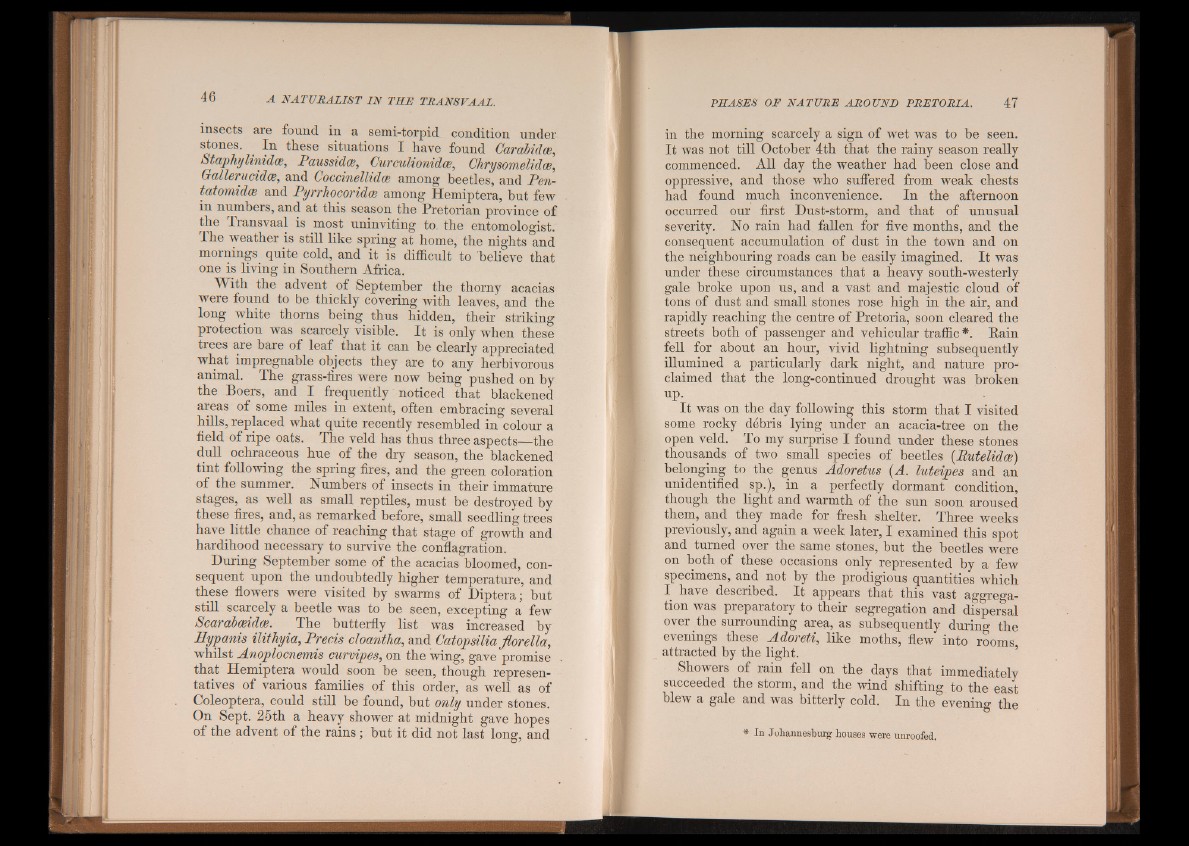
insects are found in a semi-torpid condition under
stones. _ In these situations I have found Carabidce,
Staphylinidce, Paussidce, Curculionidce, Chrysomelidce,
Galleruddw, and Cocdnellidce among beetles, and Pen-
tatomidaz and Pyrrhocondce among Hemiptera, but few
in numbers, and at this season the Pretorian province of
the Transvaal is most uninviting to. the entomologist.
Ih e weather is still like spring at home, the nights and
mornings quite cold, and it is difficult to believe that
one is living in Southern Africa.
With the advent of September the thorny acacias
were found to be thickly covering with leaves, and the
long white thorns being thus hidden, their striking
protection was scarcely visible. It is only when these
trees are bare of leaf that it can be clearly appreciated
what impregnable objects they are to any herbivorous
animal. The grass-fires were now being pushed on by
the Boers, and I frequently noticed that blackened
areas of some miles in extent, often embracing several
hills, replaced what quite recently resembled in colour a
field of ripe oats. The veld has thus three aspects—the
dull ochraceous hue of the dry season, the blackened
tint following the spring fires, and the green coloration
of the summer. Numbers of insects in their immature
stages, as well as small reptiles, must be destroyed by
these fires, and, as remarked before, small seedling trees
have little chance of reaching that stage of growth and
hardihood necessary to survive the conflagration.
During September some of the acacias bloomed, consequent
upon the undoubtedly higher temperature, and
these flowers were visited by swarms of Diptera; but
still scarcely a beetle was to be seen, excepting a few
Scarabmdce. The butterfly list was increased by
Hypanis ilithyia, Precis cloantha, and Catopsilia florella,
whilst Anoplocnemis curvipes, on the wing, gave promise
that Hemiptera would soon be seen, though representatives
of various families of this order, as well as of
Coleoptera, could still be found, but only under stones.
On Sept. 25th a heavy shower at midnight gave hopes
of the advent of the rains; but it did not last long, and
in the morning scarcely a sign of wet was to be seen.
It was not till October 4th that the rainy season really
commenced. All day the weather had been close and
oppressive, and those who suffered from weak chests
had found much inconvenience. In the afternoon
occurred our first Dust-storm, and that of unusual
severity. No rain had fallen for five months, and the
consequent accumulation of dust in the town and on
the neighbouring roads can be easily imagined. It was
under these circumstances that a heavy south-westerly
gale broke upon us, and a vast and majestic cloud of
tons of dust and small stones rose high in the air, and
rapidly reaching the centre of Pretoria, soon cleared the
streets both of passenger and vehicular traffic *. Rain
fell for about an hour, vivid lightning subsequently
illumined a particularly dark night, and nature proclaimed
that the long-continued drought was broken
up.
It was on the day following this storm that I visited
some rocky debris lying under an acacia-tree on the
open veld. To my surprise I found under these stones
thousands of two small species of beetles (Rutelidce)
belonging to the genus Adoretus (A. luteipes and an
unidentified sp.), in a perfectly dormant condition,
though the light and warmth of the sun soon aroused
them, and they made for fresh shelter. Three weeks
previously, and again a week later, I examined this spot
and turned over the same stones, but the beetles were
on both of these occasions only represented by a few
specimens, and not by the prodigious quantities which
I have described. It appears that this vast aggregation
was preparatory to their segregation and dispersal
over the surrounding area, as subsequently during the
evenings these Adored, like moths, flew into rooms
attracted by the light.
Showers of rain fell on the days that immediately
succeeded the storm, and the wind shifting, to the east
blew a gale and was bitterly cold. In the evening the
* In Johannesburg houses were unroofed.